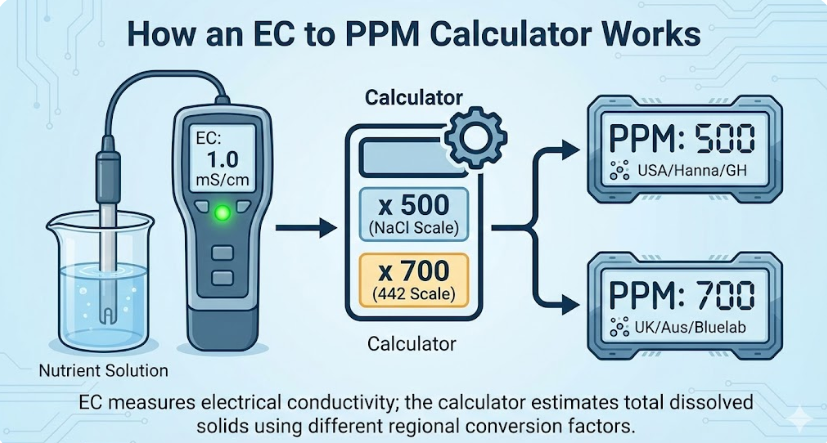EC to PPM Calculator
EC to PPM Nutrient Calculator – Hydroponics & Growers Conversion Tool
Convert EC measurements to TDS/PPM using industry-standard factors. Ideal for water testing, laboratories, environmental monitoring, and precision nutrient dosing.
Are you a hydroponics enthusiast, a commercial grower, or a home gardener trying to get your nutrient mix just right? Understanding the relationship between Electrical Conductivity (EC) and Parts Per Million (PPM) is crucial for a healthy garden.
This guide, along with our simple EC to PPM calculator, is designed to help you quickly convert these values so you can stop guessing and start growing with confidence.
What is the Difference Between EC and PPM?
This is a common question, and the answer is key to proper nutrient management.
- EC (Electrical Conductivity): This is the universal, direct measurement of your nutrient solution’s strength. It measures how well the solution conducts electricity, which is directly proportional to the amount of dissolved mineral salts (ions) in it. The unit for EC is typically millisiemens per centimeter (mS/cm). This is the most reliable metric because it’s a raw, objective data point.
- PPM (Parts Per Million): This value represents the concentration of dissolved solids. Unlike EC, PPM is not a direct measurement. Instead, it’s a calculated value derived from the EC reading using a conversion factor. This is where the confusion often arises, as different meter manufacturers use different scales.
How to Convert EC to PPM: The Different Scales
Because PPM is a derived value, you must know which scale your meter uses. The two most common scales are the 500 scale and the 700 scale.
- The 500 Scale (Hanna, Truncheon): This scale is widely used and is often referred to as the “Hanna scale.” The conversion formula is straightforward:
- PPM = EC (in mS/cm) × 500
- The 700 Scale (Bluelab, Eutech): Also known as the “Bluelab scale,” this scale provides a different PPM value for the same EC reading.
- PPM = EC (in mS/cm) × 700
For example, an EC reading of 2.0 mS/cm would convert to 1000 PPM on the 500 scale and 1400 PPM on the 700 scale. This significant difference highlights why it’s so important to know your meter’s specific conversion factor.

Using Our EC to PPM Calculator
Our tool simplifies this process. You’ll never have to do the math manually again. Simply:
- Enter Your EC Value: Input the reading from your EC meter into the designated field.
- Select Your Scale: Choose either the “500 scale” or “700 scale” from the dropdown menu, based on your meter’s specifications.
- Get Your Result: The calculator will instantly display your PPM value, helping you make quick, informed decisions about your nutrient mix.
Why is This So Important for My Plants?
Getting your nutrient solution’s strength right is critical for plant health and yield. Too low of a PPM can lead to nutrient deficiencies, while too high can cause nutrient burn, stunting growth and potentially killing your plants.
By accurately converting your EC reading to PPM, you can ensure your plants are receiving the optimal concentration of nutrients for their specific growth stage. This simple step can be the difference between a struggling garden and a thriving one.
Calculate PPM quickly and accurately. Convert concentration, dilution, chemical dosing, and mass-to-volume ratios using this easy PPMCalculator for chemistry, water treatment, labs, and industry.
